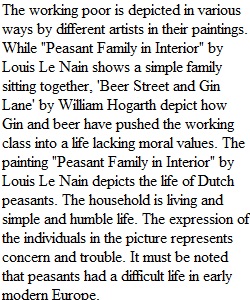


Q Using all four (4) images and at least six (6) primary sources, discuss the different kinds of work and leisure activities engaged in by the working poor of Europe. The images reflect the views of the artists who created them for elite audiences and each of them tell a story with a distinct moral message. Compare and contrast these depictions of the poor, especially as compared with what other sources tell us about their actual experiences. Read W-H, Ch. 12, "Economics and Technology, 1600-1789", pp. 452-488. The weekly quiz is based on this week's readings. Essay Rubric Your essay will be evaluated using the rubric below for a total of 30 possible points. You are all encouraged to use the Discussion Board to post questions or offer your views on these aspects of the project for others and also me to consider. I will also post some initial thoughts to help get you all started. Weak Strong Addresses the Problem 1 2 3 4 5 Effective Written Communication 1 2 3 4 5 Demonstrates Understanding 1 2 3 4 5 Level of Analysis and Groupings 1 2 3 4 5 Evaluation of Primary Sources 1 2 3 4 5 Considers Continuity versus Change Over Time 1 2 3 4 5 Refer to these learning objectives as you prepare all your postings. The points you receive will reflect my overall evaluation of how well you achieve each learning objective. Addresses All the Tasks in the Problem Statement Have you answered each part of the problem? Is your answer balanced or do you focus excessive attention on one part(s) and hardly any on other part(s)? Effective Written Communication Is the writing grammatically correct? Are you using words correctly? Do you open and close your main posting with a brief summary statement that introduces or concludes the essay? Do you organize your essay into paragraphs? Do they build one then to another into an argument? Demonstrates Understanding of the Material Have you used the material provided effectively to engage the tasks in the problem? Do you make specific and correct reference to the various materials in the assignment to support your analysis? Level of Analysis Do you simply describe or summarize the evidence (not good) or do you evaluate and interpret the evidence (good) to address the problem? Do you build your analysis by grouping two or more primary sources to explain by their relationship an aspect of the problem? Evaluation of Primary Sources What perspective is reflected in the primary source? For example, is it an official document, or a personal expression, or an artistic representation? What purpose was the document created for? How reliable is the document? A good place to begin assessing point of view is to ask who, what, where, when and how this particular document came to be created. If any of that is especially pertinent to the problem you’re addressing, make sure to mention it. Considers Continuity versus Change over Time History is never all about continuity or all about change, but really a relative mix of the two. Think through what kind of historical process you see as you develop your analysis. What factors drive forward change? What factors create an impediment to change? Is it a continuous or discontinuous process of change? Your assessment should try to be specific time (when) and place (where) so that you situate your discuss in the proper historical context. Be careful not to overly generalize for all of Europe in your analysis.
View Related Questions